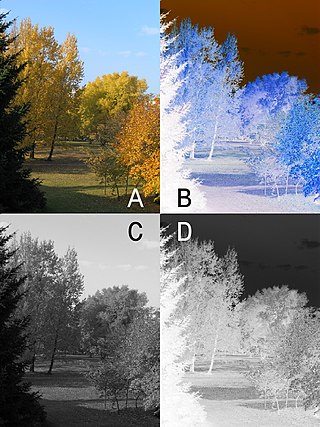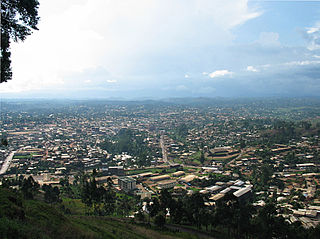
A photograph is an image created by light falling on a photosensitive surface, usually photographic film or an electronic image sensor, such as a CCD or a CMOS chip. Most photographs are now created using a smartphone or camera, which uses a lens to focus the scene's visible wavelengths of light into a reproduction of what the human eye would see. The process and practice of creating such images is called photography.

In photography, a negative is an image, usually on a strip or sheet of transparent plastic film, in which the lightest areas of the photographed subject appear darkest and the darkest areas appear lightest. This reversed order occurs because the extremely light-sensitive chemicals a camera film must use to capture an image quickly enough for ordinary picture-taking are darkened, rather than bleached, by exposure to light and subsequent photographic processing.

A darkroom is used to process photographic film, make prints and carry out other associated tasks. It is a room that can be made completely dark to allow the processing of light-sensitive photographic materials, including film and photographic paper. Various equipment is used in the darkroom, including an enlarger, baths containing chemicals, and running water.

A contact print is a photographic image produced from film; sometimes from a film negative, and sometimes from a film positive or paper negative. In a darkroom an exposed and developed piece of film or photographic paper is placed emulsion side down, in contact with a piece of photographic paper, light is briefly shone through the negative or paper and then the paper is developed to reveal the final print.

Bamenda, also known as Abakwa and Mankon Town, is a city in northwestern Cameroon and capital of the Northwest Region. The city has a population of about six hundred thousand people and is located 366 km (227 mi) north-west of the Cameroonian capital, Yaoundé. Bamenda is known for its cool climate and scenic hilly location.

Cameroon is a Central African nation on the Gulf of Guinea. Bantu speakers were among the first groups to settle Cameroon, followed by the Muslim Fulani until German domination in 1884. After World War I, the French took over 80% of the area, and the British 20%. After World War II, self-government was granted, and in 1972, a unitary republic was formed out of East and West Cameroon. Until 1976 there were two separate education systems, French and English, which did not merge seamlessly. English and French are now considered the primary languages of instruction with English being more preferred. Local languages are generally not taught as there are too many, and choosing between them would raise further issues.
Articles related to Cameroon include:

Buea is the capital of the Southwest Region of Cameroon. The city is located in Fako Division, on the eastern slopes of Mount Cameroon, and has a population of about 800.000 inhabitants as of 2023. It has two Government Hotels, the Mountain Hotel and Parliamentarian Flats Hotel located around The Government Residential Area.
A chromogenic print, also known as a C-print or C-type print, a silver halide print, or a dye coupler print, is a photographic print made from a color negative, transparency or digital image, and developed using a chromogenic process. They are composed of three layers of gelatin, each containing an emulsion of silver halide, which is used as a light-sensitive material, and a different dye coupler of subtractive color which together, when developed, form a full-color image.

Analog photography, also known as film photography, is a term usually applied to photography that uses chemical processes to capture an image, typically on paper, film or a hard plate. These processes were the only methods available to photographers for more than a century prior to the invention of digital photography, which uses electronic sensors to record images to digital media. Analog electronic photography was sometimes used in the late 20th century but soon died out.
The mass media in Cameroon includes independent outlets. The nation has only one national newspaper, which is state owned.
The National Archives of Cameroon is the national archives of Cameroon, established in 1966. Its main location is in Yaoundé and has a library which holds 64,000 volumes. There is an annex in Buea with early material. Maintenance of the National Archives falls within the responsibilities of the Ministry of Arts and Culture. The archive closed in 2016 for what promises to be a long running reorganization and digitization of its files. Researchers can still request access by writing to the director with a list of specific documents they wish to access. It is also possible to order digital photos of documents for a fee.
Sahndra Fon Dufe is a Cameroonian actress, author, screenwriter, film producer, and CEO of the Indie production house African Pictures International. She has appeared in several international movies, including One Night in Vegas and Black November. Cameroonian singer Said Barah has referred to her as "Young Oprah" in one of his songs called Sahndra Fon Dufe, in admiration for her creative ingenuity and inspirational influence for young women all over Africa.
Bate Besong (1954–2007) was a Cameroonian playwright, poet and critic, who was described by Pierre Fandio as “one of the most representative and regular writers of what might be referred to as the second generation of the emergent Cameroonian literature in English". He died on March 8, 2007, in a car accident on the Douala-Yaounde highway.
Linus Tongwo Asong was a novelist from the British Southern Cameroons. Born in 1947 in Lewoh (Fotabong) in the former British Southern Cameroons at the end of the Second World War, he became known as an intellectual, novelist, painter, literary critic, publisher and comedian. He died at Mbingo Hospital on Monday, July 16, 2012 at about 1:00 p.m. WAT. He had just retired from the University of Bamenda in June 2012 and was about to take up a position as a Dean at the Catholic University of Cameroon, Bamenda. He also worked with his nephew, Januarius Jingwa Asongu to get Saint Monica University off the ground, a project that his daughter, Laura Asong, helped bring to reality. He was married to Teresa Ajab Asong and had three children - Laura, Stephen, and Edward.

Jacques Toussele was a Cameroonian photographer from Bamessingué near Mbouda in the Western Region of Cameroon.
This is a timeline of the Anglophone Crisis during 2019.
This is a timeline of the Anglophone Crisis during 2020.
Joseph Chila is a Cameroonian photographer from Mbouda in the West Region of Cameroon. For most of his working life he was based in Mayo-Darlé in Adamawa Region.

Samuel Finlak 1958-2023 was a Cameroonian photographer originally from the Yamba village of Bongor, Ngwa, in Northwest Province of Cameroon. For most of his working life he was the resident photographer in Atta Village, Adamawa Region. He died on 8 January 2023.











